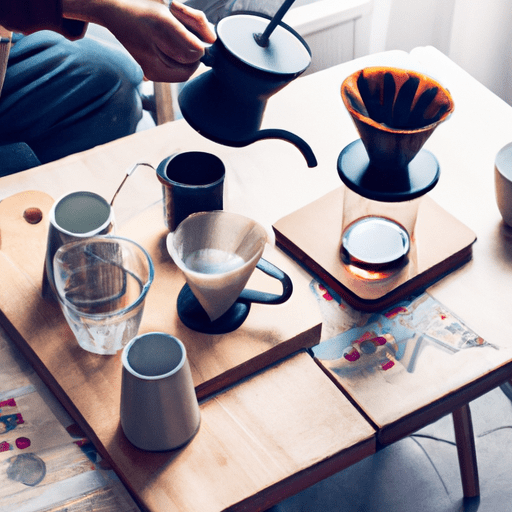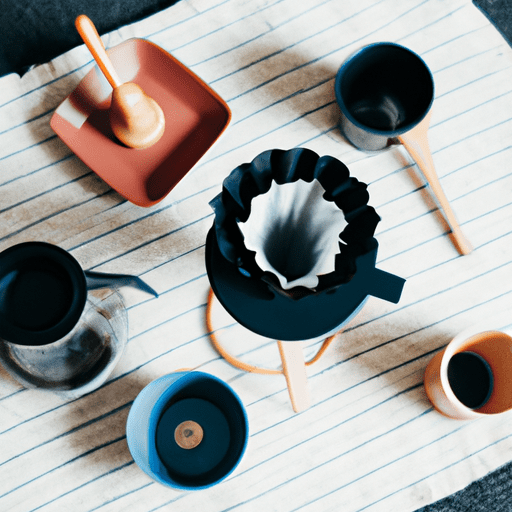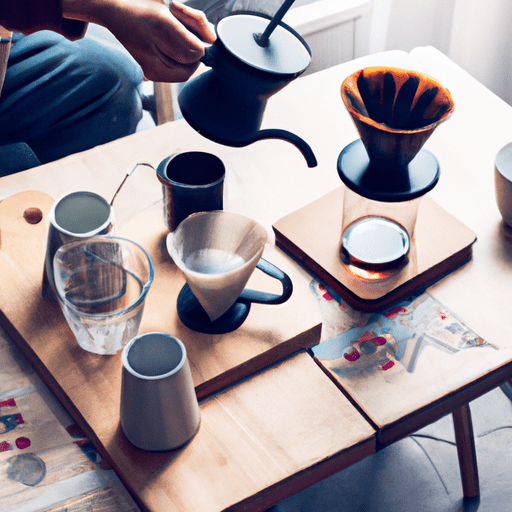Get ready to elevate your morning routine! In “Mastering the Art of Pour Over Coffee Without a Dripper”, you will learn how to create the perfect pour over coffee even if you don’t own a dripper. This article is perfect for the coffee connoisseur looking for an alternative brew method or the at-home barista seeking out a new challenge. Your key to a stronger, more flavorful, and exquisitely handcrafted cup of coffee is just a breath away. So, brace yourself for an exciting and rewarding journey. Your taste buds will thank you!

What is Pour Over Coffee?
Ever wondered why some coffee enthusiasts swear by pour over coffee? In essence, pouring over is a method of brewing coffee manually, directly into your cup. This simple yet sophisticated coffee brewing technique involves pouring hot water over ground coffee beans, which then drip through a filter and into your cup. This meticulous process offers an unparalleled opportunity to appreciate the diverse flavors and aromas packed in your coffee beans.
Explanation of Pour Over Coffee
Imagine the satisfaction of taking control of every step of coffee brewing – that’s precisely what pour-over coffee offers. Pour-over coffee is about more than just brewing a cup of coffee; it’s an engaging ritual that heightens the coffee drinking experience. You carefully measure, grind, and steep your coffee beans, controlling every variable to tailor the coffee’s strength and flavor to your specific preference.
Benefits Of Pour Over Coffee
Now you might be thinking, why would I go through such a process when I can just hit a button on an automatic machine? Well, the truth is, pour over coffee has its unique benefits. First, it gives you total control over the brewing process, allowing you to adjust each variable to your liking. Second, it often produces a cleaner taste compared to automatic machines because it involves paper filters that trap oils and sediments. Finally, it brings a feeling of satisfaction and accomplishment as you have a hand in creating your perfect cup.
The Importance of a Dripper
Anyone who knows pour over coffee knows that a dripper plays a critical role. It’s a tool designed to hold the filter and coffee grounds and permit water to flow through them.
What is a Dripper and How Does it Work?
A dripper, also known as a brewer, is a small device typically made of ceramic, glass, metal, or plastic. Placed on top of a cup or pot, it holds the coffee filter filled with coffee grounds. You then pour hot water over the grounds, and your coffee slowly drips into the receiver below.
Why Drippers Are Commonly Used in Pour Over Coffee
Drippers offer a pathway for water to flow evenly over the coffee grounds, ensuring all the grounds are saturated for optimal extraction. Using a dripper allows for a consistent and measured water flow, which is essential for a balanced, flavorful cup of coffee. It also helps to maintain the required brew time for the perfect extraction.
Alternative Brewing Methods
While pour over coffee holds its charm, other brewing methods also have their unique attributes that are worth exploring. Here are some alternatives you could try:
Using a French Press
The French press is another popular method for brewing coffee. What sets it apart is that it allows the coffee to steep in hot water—much like tea—giving a bolder, fuller-bodied coffee taste.
Using a Chemex
Chemex is a versatile pour over coffee maker known for its elegant design. It’s perfect for brewing larger batches of coffee. It employs a thicker paper filter, which results in an especially clean and refined coffee taste.
Using a Cloth Filter
Cloth filters, popular in various parts of the world, are reputed for the rich and complex brews they yield. While they require more maintenance than paper filters, they allow you to enjoy the oils often trapped by paper filters, offering an incredibly smooth and full-bodied cup of coffee.

Mastering the Technique
Mastering the art of pour over coffee involves a few key steps. Let’s break them down:
Choosing the Right Coffee Beans
Each coffee bean varietal comes with a unique flavor profile—chocolatey, fruity, nutty—the list is endless. When selecting coffee beans for your pour over, keep in mind that this brew method accentuates subtle flavors, so choose beans that have flavor notes you enjoy.
Grinding the Coffee Beans
Grinding your beans fresh makes a significant difference in your coffee’s taste, as fresher grounds retain more of their flavors and aromatics. For pour over, a medium to medium-coarse grind size typically works well.
Preparing the Water
The quality of water used in brewing coffee is critical. Aim for water that’s clean and free from strong tastes or odors. The temperature of the water also matters; the sweet spot is usually between 195 to 205 degrees Fahrenheit.
Pre-wetting the Coffee Grounds
Before brewing, you want to pre-wet your coffee grounds. This process, also known as blooming, involves pouring a bit of hot water over the grounds to release carbon dioxide trapped in them during roasting. Blooming allows for better water-to-coffee contact and richer extraction of flavors.
The Pour-Over Process
The key to pour over brewing is maintaining a slow, steady pour. Start at the center of the grounds and work your way to the outer edges in a circular motion, ensuring all grounds are evenly saturated. Repeat this process until you reach your desired water level.
Adjusting the Pour Rate and Water Temperature
Your pour speed and water temperature can significantly impact your brew. A slow pour rate can lead to over-extraction and a bitter cup, while a fast pour can lead to under-extraction and a weak, sour cup. So, take your time and adjust as necessary. Similarly, play with temperature; remember, hotter water extracts more aggressively than cooler water.
Improvising a Dripper
Sometimes, you might find yourself without a proper dripper. Fear not, you can still enjoy pour-over coffee with some creativity and common household items.
Choosing a Suitable Substitute
A good substitute for a dripper would be something that can hold a filter and sit on top of a cup. Options could range from a small sieve or strainer to a colander, depending on the size of your cup.
Using a Paper Towel or Coffee Filter
If you don’t have a coffee filter handy, a paper towel can do the trick. Simply shape it into the substitute dripper and ensure it’s secure before adding your coffee grounds. Be sure to wet the towel or filter before adding the grounds to remove any paper taste.
Creating a Makeshift Dripper With Household Items
In a pinch, you could even turn to a narrow-necked bottle or tin can. Cut off the bottom, place your filter inside, secure it, and voila! You have a DIY dripper.
Tips and Tricks
Mastered the basics of pour over brewing? Time to fine-tune and elevate your brew with these tips and tricks.
Getting the Right Grounds to Water Ratio
A general guideline is 60 grams of coffee to 1 liter of water, but feel free to adjust this ratio until you find your perfect balance.
Finding the Right Pouring Technique
The pouring technique is also critical. Aim for a steady, circular pour, starting from the middle and moving outward to prevent any grounds from sticking to the sides.
Experimenting With Different Brewing Times
Each coffee type requires a slightly different brew time, generally anywhere from 2-4 minutes for pour over. Experiment to see what suits your palate best.
Tasting and Adjusting the Strength of the Coffee
The beauty of pour over coffee is the control it gives you over your brew’s strength. If your coffee tastes too weak or too strong, adjust the amount of ground coffee or water accordingly.
Troubleshooting
Just as with any brewing method, you might run into a few bumps in the road when making pour over coffee.
Coffee Brewing Too Slowly
This could be a sign that your grind is too fine, which restricts water flow. Try adjusting to a coarser grind.
Coffee Brewing Too Quickly
Conversely, if the water is flowing through your grounds too quickly, your coffee may taste weak or underextracted. Make the grind finer to slow down the water flow.
Uneven Extraction of Flavor
If your coffee tastes off, it could be due to uneven extraction. This could happen if all your grounds aren’t fully saturated, or your pour rate is too fast. Take care to pour evenly and slowly.
Undesirable Flavors in the Coffee
If your coffee has a papery, metallic, or odd taste, it could be from the filter. Make sure to pre-wet it before adding your grounds. If the flavor continues, consider switching to a different filter material.
Cleaning and Maintenance
Like any coffee gear, your pour over equipment also needs regular cleaning and care.
Care for the Improvised Dripper
Even if it’s makeshift, your DIY dripper needs to be cleaned after each use. Rinse with warm water and be gentle to avoid damaging it.
Removing Coffee Stains
Coffee stains can accumulate over time and affect your brew’s taste. Use a mix of baking soda and water to scrub away stubborn stains.
Storage of Pour Over Equipment
Make sure all your pour over equipment is dry before storing to prevent mold or stale, trapped coffee smells. Store in a clean, dry place.
Exploring Different Pour Over Devices
Once you’ve mastered the basics, you could explore other pour over devices.
Woodneck
The Woodneck is a Drip Pot made by Hario, Japan, and employs a reusable cloth filter, making for a smooth brew.
Bee House
Bee House is a ceramic dripper well-loved for its ease of use, making it a great starting point for pour-over beginners.
Clever Coffee Dripper
The Clever Dripper combines immersion brewing and pour over brewing, giving you the best of both worlds. It offers the full-bodied flavor of French Press and the clarity of a pour over.
Final Thoughts
Mastering the pour-over coffee technique without a dripper requires experimentation, attention to detail, and a bit of creativity. However, the reward of personalizing and refining your brew while indulging in the meditative ritual of pour over makes it entirely worth the effort. So grab your coffee beans and hot water, and dive into the world of pour over coffee – no dripper required! You’ll brew not just coffee, but memories and experiences that make every cup an adventure. Bon appétit, and happy brewing!
